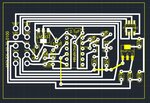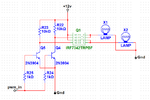svizoman
Junior Member level 3

Bellow is my circuit design. I am using dual p channel mosfet (FDS4935BZ) to dimm two H7 bulbs using PIC PWM. Since bulbs are connected to the ground in the headlight itself I can only use P channel mosfet. Since P channel mosfet is on when 0V is on the gate I am also using third P channel mosfet to provide 12V from the car's ignition to the gate of dual channel mosfet that actualy controls the current through two H7 bulbs. So when PWM from the PIC is 0 bulbs shoud be dimmed to 0 and when PWM from PIC is 255 bulbs should shine with full brightnes.
Problem is that none of this worked. Bulbs shined at full brightnes even when PWM was set to 50 (20% duty so should be 1V) and also circuit started to overheat. Strange thing is that third mosfet (ZXMP7A17G) that only controls voltage to gate of dual mosfet got burned out.


Yellow lines are wire connections on the other side of PCB. All the surface mount ICs yellow markings are shown mirrored since they are fliped over on the other side when soldered!
Problem is that none of this worked. Bulbs shined at full brightnes even when PWM was set to 50 (20% duty so should be 1V) and also circuit started to overheat. Strange thing is that third mosfet (ZXMP7A17G) that only controls voltage to gate of dual mosfet got burned out.


Yellow lines are wire connections on the other side of PCB. All the surface mount ICs yellow markings are shown mirrored since they are fliped over on the other side when soldered!






